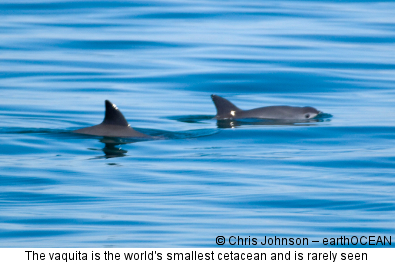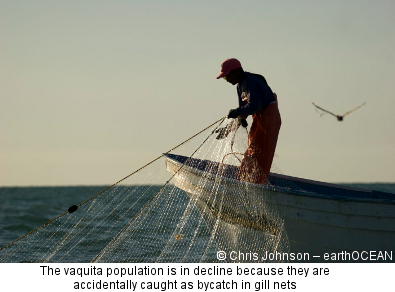This is the first in a series of blogs written by George Tyson, a graduate journalist with a keen interest in conservation.
As the conditions of global fishing hit the headlines and catch the attention of the public with Hugh Fearnley-Whittingstall’s Fish Fight, an accidental victim to the tragedy of bycatch through trawling continues to suffer.
The future of the world’s smallest and most endangered species of cetacean hangs in the balance. The vaquita (or ‘little cow’) exists in the shallow waters of a small pocket of the Gulf of California and is the only endemic marine mammal to be found there. Its skin has a distinctive dark to light grey fade, with dark rings around its eyes and mouth. With as little as 150 thought to remain in the wild, predictions forecast that the vaquita could be extinct within the next two years.

Even as specific data regarding detailed population numbers is yet to be released, a disturbingly bleak picture is easy to create. Despite no hunting directly targeted at the elusive porpoise, the vaquita suffers a devastatingly high fishing related mortality. Coupled with a relatively small distribution of 900 largely unprotected radial miles, accidental capture and entangling is decimating their numbers.
A survey conducted in 2000 showed that between 39 and 84 individuals per year fall incidental victim to the nets of the local fishing industry. Trawls and gillnets intended for catching shrimp, rays, finfish and shark are largely responsible for this overwhelming mortality rate, and according to those working to protect the species, only a total overhaul of these fishing practices will provide the vaquita with any hope of survival.
With population numbers estimated as low as they are, and with the smallest known habitat of any marine mammal in the world, conservation of the vaquita is a formidable task. Sadly, there are yet more obstacles stacked against any effort to preserve the existence of this tiny cetacean. While prevention of incidental bycatch is the immediate concern, damming of the Colorado River is argued to be restricting the Gulf of California’s source of nutrients, continually altering the vaquita’s habitat. There are also concerns of chemical pollution and low genetic variability as a result of their small population size.
The future of the vaquita may appear bleak, but a considerable conservation effort exists for the continuation of the world’s most endangered marine mammal. Classified as critically endangered by the IUCN Red List and firmly amongst EDGE’s top 100 mammals, the plight of the vaquita is widely acknowledged. In 2008, a North American Conservation Action Plan (NACAP) for the vaquita was initialized. Alongside the International Committee for the Recovery of the Vaquita (CIRVA), the elimination of the bycatch of the vaquita is a target set by the groups that is easily achievable, however further support for local fishing communities is in dire need for this target to become a reality. With alternative fishing technology and proper enforcement and extension of the Colorado River Delta Biosphere Reserve, the vaquita can be saved from the edge of extinction – with radically sliding population numbers and intensive fishing on the rise, the time for action is now.
George Tyson
You can find out more about the vaquita at Https://vaquita.tv which also features short films following the research and conservation efforts being made to save this species.
You can find out more about supporting EDGE here.
Please note: Photos taken under permit (Oficio No. DR/847/08 ) from the Comisión Nacional de Áreas Naturales Protegidas (CONANP/Secretaría del Medio Ambiente y Recursos Naturales (SEMARNAT), within a natural protected area subject to special management and decreed as such by the Mexican Government. This work was made possible thanks to the collaboration and support of the Coordinador de Investigación y Conservación de Mamíferos Marinos at the Instiuto Nacional de Ecología (INE).

